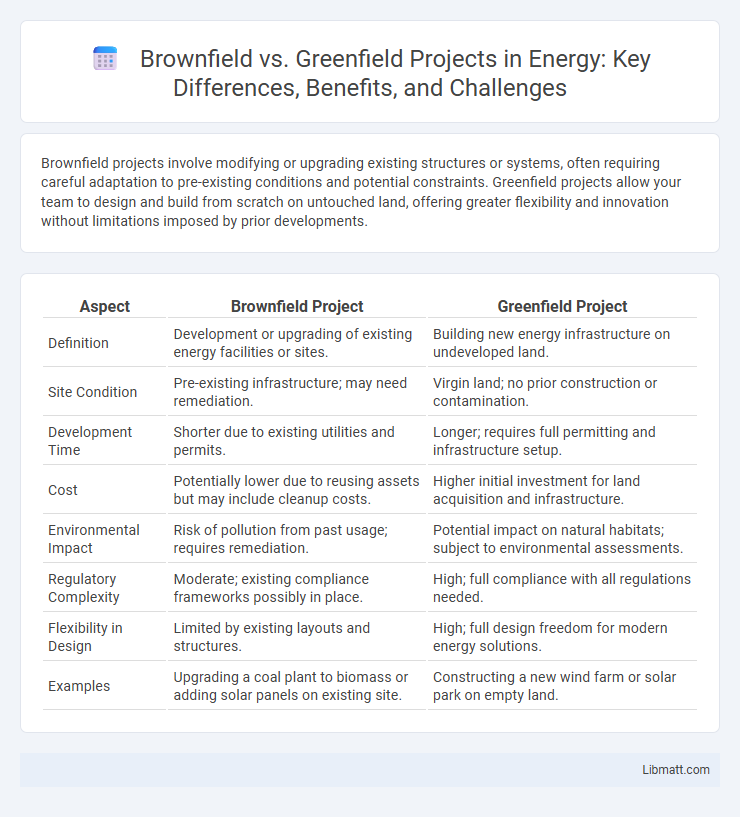Brownfield projects involve modifying or upgrading existing structures or systems, often requiring careful adaptation to pre-existing conditions and potential constraints. Greenfield projects allow your team to design and build from scratch on untouched land, offering greater flexibility and innovation without limitations imposed by prior developments.
Table of Comparison
| Aspect | Brownfield Project | Greenfield Project |
|---|---|---|
| Definition | Development or upgrading of existing energy facilities or sites. | Building new energy infrastructure on undeveloped land. |
| Site Condition | Pre-existing infrastructure; may need remediation. | Virgin land; no prior construction or contamination. |
| Development Time | Shorter due to existing utilities and permits. | Longer; requires full permitting and infrastructure setup. |
| Cost | Potentially lower due to reusing assets but may include cleanup costs. | Higher initial investment for land acquisition and infrastructure. |
| Environmental Impact | Risk of pollution from past usage; requires remediation. | Potential impact on natural habitats; subject to environmental assessments. |
| Regulatory Complexity | Moderate; existing compliance frameworks possibly in place. | High; full compliance with all regulations needed. |
| Flexibility in Design | Limited by existing layouts and structures. | High; full design freedom for modern energy solutions. |
| Examples | Upgrading a coal plant to biomass or adding solar panels on existing site. | Constructing a new wind farm or solar park on empty land. |
Introduction to Brownfield and Greenfield Projects
Brownfield projects involve the redevelopment or expansion of existing facilities or sites that often require remediation or upgrading, commonly seen in urban or industrial contexts. Greenfield projects refer to construction on undeveloped land, offering a blank slate for new infrastructure without the constraints of existing structures or contamination. Both project types present unique challenges and opportunities related to environmental impact, cost, and regulatory compliance.
Key Definitions: Brownfield vs Greenfield
Brownfield projects involve the redevelopment or upgrading of existing facilities, infrastructure, or land that has been previously used, often requiring environmental cleanup or adaptation to current standards. Greenfield projects refer to initiatives built from scratch on undeveloped land with no constraints from prior work, allowing more flexibility in design and implementation. Understanding these distinctions is crucial for project planning, environmental impact assessment, and regulatory compliance in industries such as construction, manufacturing, and technology.
Advantages of Brownfield Projects
Brownfield projects offer significant advantages, including reduced initial development time and costs due to existing infrastructure and utilities. These projects support sustainability by promoting the reuse of land and minimizing urban sprawl, aligning with environmental regulations and community revitalization efforts. Companies benefit from quicker market entry and potential tax incentives related to redevelopment in established areas.
Advantages of Greenfield Projects
Greenfield projects offer the advantage of complete design freedom, allowing for the implementation of the latest technology and modern infrastructure without constraints from existing structures. These projects enable optimal site selection, which can improve operational efficiency, environmental sustainability, and scalability for future expansion. Furthermore, greenfield developments often result in lower maintenance costs and fewer regulatory complications compared to brownfield projects, which involve renovating or upgrading existing facilities.
Challenges in Brownfield Development
Brownfield development faces significant challenges including environmental contamination, which requires extensive site assessment and remediation to meet regulatory standards. You must navigate complex zoning laws and obtain permits that account for existing infrastructure constraints, often increasing project timelines and costs. Legacy structures and underground utilities further complicate construction, demanding specialized engineering solutions to ensure safety and compliance.
Challenges in Greenfield Development
Greenfield development faces significant challenges such as higher initial capital investment, extended timelines for infrastructure setup, and complex regulatory approvals. You must navigate environmental impact assessments and zoning restrictions, which can delay project progress and increase costs. Managing logistics in undeveloped areas requires careful planning to ensure efficient resource allocation and workforce onboarding.
Cost Considerations: Brownfield vs Greenfield
Brownfield projects often involve lower initial costs due to existing infrastructure but can incur higher expenses from remediation and compliance with regulations. Greenfield projects demand significant upfront investment for land acquisition and development but typically offer fewer hidden liabilities. Understanding these cost dynamics helps you strategically allocate budget and manage financial risks effectively.
Environmental Impact Comparison
Brownfield projects typically involve redevelopment of previously used land, often requiring environmental remediation due to existing pollution or contamination, which can reduce urban sprawl and preserve natural habitats. Greenfield projects, built on undeveloped land, generally have a higher environmental impact by disrupting ecosystems, increasing habitat loss, and contributing to soil erosion and carbon emissions. Your decision between the two should consider these environmental trade-offs, balancing land reuse benefits against potential ecological disturbances.
Regulatory and Compliance Factors
Brownfield projects often face stringent regulatory and compliance challenges due to pre-existing environmental liabilities, requiring extensive site assessments and remediation to meet government standards. Greenfield projects typically encounter fewer regulatory hurdles initially but must comply with zoning laws, environmental impact assessments, and building codes from the ground up. Navigating the complex regulatory landscape is crucial for both types to ensure project approval, avoid legal penalties, and achieve sustainable development goals.
Choosing Between Brownfield and Greenfield Projects
Choosing between Brownfield and Greenfield projects depends on factors such as budget constraints, project timeline, and environmental impact assessments. Brownfield projects often offer cost savings through existing infrastructure reuse but may require extensive remediation, while Greenfield projects provide greater design flexibility and cleaner site conditions at higher initial costs. Decision-makers evaluate site location, regulatory requirements, and long-term operational efficiency to determine the optimal project type aligned with their strategic goals.
Brownfield vs Greenfield Project Infographic

 libmatt.com
libmatt.com